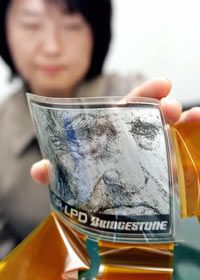Products with Nanotechnology
You might be surprised to find out how many products on the market are already benefiting from nanotechnology.

- Sunscreen - Many sunscreens contain nanoparticles of zinc oxide or titanium oxide. Older sunscreen formulas use larger particles, which is what gives most sunscreens their whitish color. Smaller particles are less visible, meaning that when you rub the sunscreen into your skin, it doesn't give you a whitish tinge.
- Self-cleaning glass - A company called Pilkington offers a product they call Activ Glass, which uses nanoparticles to make the glass photocatalytic and hydrophilic. The photocatalytic effect means that when UV radiation from light hits the glass, nanoparticles become energized and begin to break down and loosen organic molecules on the glass (in other words, dirt). Hydrophilic means that when water makes contact with the glass, it spreads across the glass evenly, which helps wash the glass clean.
- Clothing - Scientists are using nanoparticles to enhance your clothing. By coating fabrics with a thin layer of zinc oxide nanoparticles, manufacturers can create clothes that give better protection from UV radiation. Some clothes have nanoparticles in the form of little hairs or whiskers that help repel water and other materials, making the clothing stain-resistant.
- Scratch-resistant coatings - Engineers discovered that adding aluminum silicate nanoparticles to scratch-resistant polymer coatings made the coatings more effective, increasing resistance to chipping and scratching. Scratch-resistant coatings are common on everything from cars to eyeglass lenses.
- Antimicrobial bandages - Scientist Robert Burrell created a process to manufacture antibacterial bandages using nanoparticles of silver. Silver ions block microbes' cellular respiration [source: Burnsurgery.org]. In other words, silver smothers harmful cells, killing them.
[source: The Ecologist]
Advertisement
New products incorporating nanotechnology are coming out every day. Wrinkle-resistant fabrics, deep-penetrating cosmetics, liquid crystal displays (LCD) and other conveniences using nanotechnology are on the market. Before long, we'll see dozens of other products that take advantage of nanotechnology ranging from Intel microprocessors to bio-nanobatteries, capacitors only a few nanometers thick. While this is exciting, it's only the tip of the iceberg as far as how nanotechnology may impact us in the future.
In the next section, we'll look at some of the incredible things that nanotechnology may hold for us.
